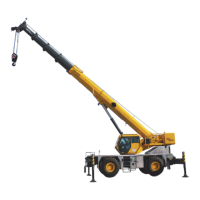1-18
Published 01-29-2014, Control # 496-00
INTRODUCTION TMS800E SERVICE MANUAL
• When replacing fixed length cable assemblies (for
example, pendants) having permanently attached end
fittings use only pre-assembled lengths of wire rope as
supplied from Manitowoc Crane Care. Do not build
lengths from individual components.
• Replace an entire wire rope assembly. Do not attempt to
rework damaged wire rope or wire rope ends.
• Never electroplate wire rope assemblies.
• Do not weld any wire rope assembly or component
unless welding is recommended by the wire rope
manufacturer. Welding spatter shall never be allowed to
come in contact with the wire rope or wire rope ends. In
addition, be sure that the wire rope is not an electrical
path during other welding operations.
• Wire ropes are manufactured from special steels. If
heating a wire rope assembly is absolutely necessary for
removal, the entire wire rope assembly shall be
discarded.
• On systems equipped with two or more wire rope
assemblies operating as a matched set, they shall be
replaced as an entire set.
• Do not paint or coat wire ropes with any substance
except approved lubricants.
Wire Rope Inspection (Running Ropes and
Pendant Cables)
Wire rope should be inspected frequently/daily and
periodically/yearly in accordance with the following
information excerpted from a National Consensus Standard
as referenced by Federal Government Agencies.
Recommended inspection intervals may vary from crane to
crane and may vary based on environmental conditions,
frequency of lifts, and exposure to shock loads. The
inspection time intervals may also be predetermined by state
and local regulatory agencies.
Any deterioration observed in the wire rope should be noted
in the equipment inspection log and an assessment
concerning wire rope replacement should be made by a
qualified person.
Frequent Inspection
A frequent daily visual inspection is recommended for all
running ropes in service. This inspection should be made on
all wire rope which can be expected to be in use during the
day’s operation. This inspection should be used to monitor
progressive degradation and to discover severe damages
necessitating wire rope replacement such as:
• Distortion, Kinking, Crushing, Un-stranding, Bird caging,
Reduction of diameter, etc.
• General corrosion.
• Broken or cut strands.
• Number, distribution and type of broken wires.
• Evidence of core failure.
• End fitting wear/abrasion.
Periodic Inspection
Wire rope should be inspected periodically/annually or at a
shorter time interval if necessitated by environmental or
other adverse conditions, and shall cover the entire length of
the wire rope. Only the outer surface of the wire rope need
be inspected, and no attempt should be made to open the
rope. Periodic inspection should include all items listed
under frequent inspection plus the following:
• Inspect for reduction of rope diameter below nominal
diameter.
• Inspect for severely corroded or broken wires at end
connections.
• Inspect for severely corroded, cracked, bent, worn, or
improperly applied end connections.
• Inspect wire rope in areas subjected to rapid
deterioration such as:
• Sections in contact with saddles, equalizer sheaves,
or other sheaves where wire rope travel is limited.
• Sections of wire rope at or near terminal ends where
corroded or broken wires may protrude.
• Inspect boom nose sheaves, hook block sheaves, jib/jib
sheaves, auxiliary boom nose sheaves, and hoist drums
for wear. Damaged sheaves or hoist drums can
accelerate wear and cause rapid deterioration of the
wire rope.
Wire Rope Inspection (Jib Extension and
Retraction Cables)
Periodic Inspection
It is recommended that a periodic inspection of all jib
extension and retraction cables be performed using the
following guidelines. This inspection shall cover the entire
length of the extension and retraction cables. This inspection
should be used to monitor progressive degradation and to
discover severe damages necessitating wire rope
replacement or equipment repair. Inspection criteria are as
follows:
• Inspect for reduction of rope diameter below nominal
diameter.
• Inspect for severely corroded or broken wires at end
connections.
• Inspect for severely corroded, cracked, bent, worn, or
improperly applied end connections.
Reference Only

